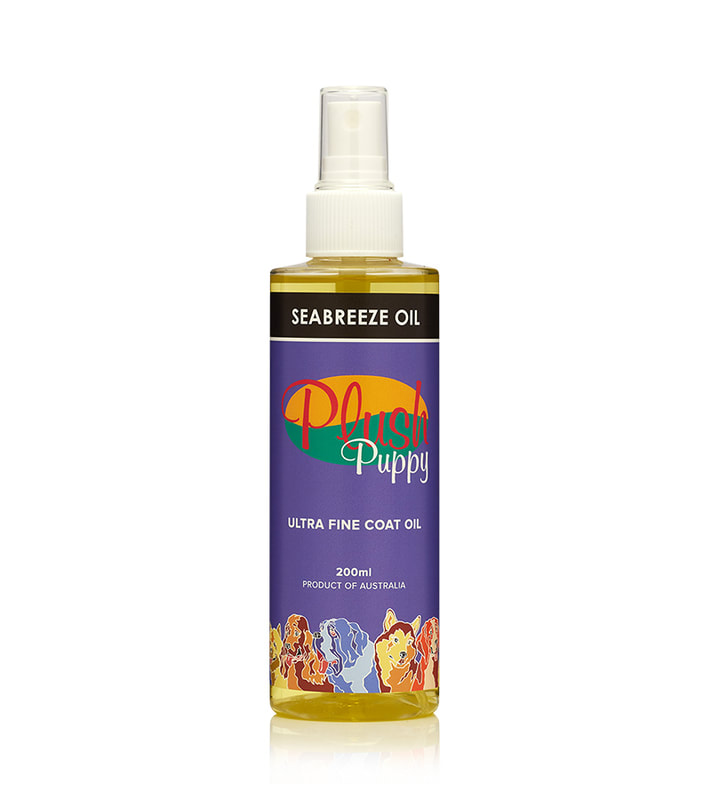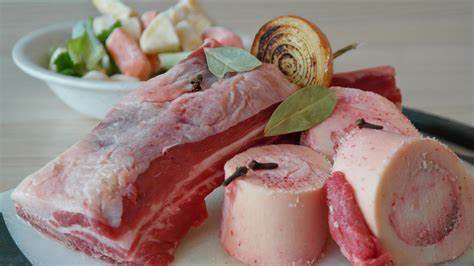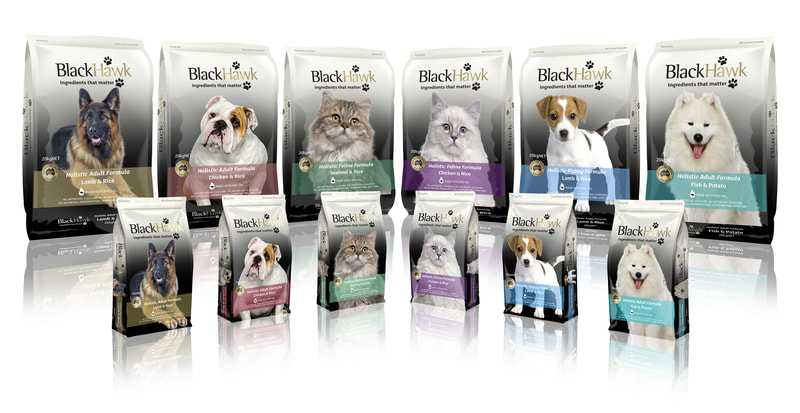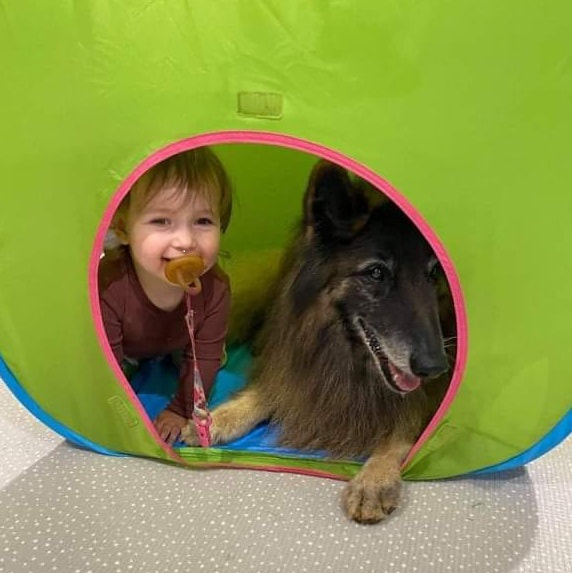ALL ABOUT BELGIAN SHEPHERDS
Four varieties - one breed. That is, the Belgian Shepherd.
Groenendael (pronounced Gro-en-en-dahl). The long coat black.
Laekenois (pronounced Lak-en-wah). The curled tousled coat fawn.
Malinois (pronounced Mal-in-wah). The short coat fawn.
Tervueren (pronounced Ter-view-ren). The long coat fawn or grey.
The dog, across all four varieties, is exactly the same in size, shape and character, according to the breed standard, except for the coat colour, coat texture and coat length. Several varieties can be born in a litter, dependent on the genes that the parents carry, and are registered with ANKC as the variety that they are born. So, a long haired fawn pup born from a litter out of two short coat fawn Malinois parents is registered as as a Tervueren. Cool, hey!
These four varieties are judged separately and can each be awarded a Challenge Certificate in the show ring.
Photo credit for top - Vivi's photo of super babies from Van Moned kennels. The black boy is our Omen as a baby before he moved to Australia.
Laekenois (pronounced Lak-en-wah). The curled tousled coat fawn.
Malinois (pronounced Mal-in-wah). The short coat fawn.
Tervueren (pronounced Ter-view-ren). The long coat fawn or grey.
The dog, across all four varieties, is exactly the same in size, shape and character, according to the breed standard, except for the coat colour, coat texture and coat length. Several varieties can be born in a litter, dependent on the genes that the parents carry, and are registered with ANKC as the variety that they are born. So, a long haired fawn pup born from a litter out of two short coat fawn Malinois parents is registered as as a Tervueren. Cool, hey!
These four varieties are judged separately and can each be awarded a Challenge Certificate in the show ring.
Photo credit for top - Vivi's photo of super babies from Van Moned kennels. The black boy is our Omen as a baby before he moved to Australia.
Breed Group
|
Working Dog.
Belgian Shepherds are Sheep Dogs from Belgium. In Australia, they are judged in Group 5 - the Working Dog Group. In Europe they are classed as the Pastoral Group. Please don't confuse Working Dogs with Working Lines. "Working line" refers to the Army, RAAF, Police forces type of Malinois that are bred to bite for security work. This is NOT the kind of temperament that the breed standard calls for, but specifically bred for security purposes. There are other options out there for families wanting companion pet Malinois, that have inherited Breed Standard traits. |
Size
Height at withers:
The ideal height at withers is on average -
62 cm for males
58 cm for females
Limits: 2cm less, 4 cm more.
Weight:
Males about 25-30kg
Females about 20-25kg
Measurements:
Average normal measures for an adult male Belgian Shepherd Dog of 62 cm at the withers:
Length of body (from point of shoulder to point of buttock) 62 cm
Length of head 25cm
Length of muzzle 12.5-13cm
Length of coat - Since the coat varies in length, direction, appearance and colour among Belgian Shepherds, this particular point has been adopted as the criterion for distinguishing between the four varieties of the breed: the Groenendael, the Tervueren, the Malinois and the Laekenois.
The ideal height at withers is on average -
62 cm for males
58 cm for females
Limits: 2cm less, 4 cm more.
Weight:
Males about 25-30kg
Females about 20-25kg
Measurements:
Average normal measures for an adult male Belgian Shepherd Dog of 62 cm at the withers:
Length of body (from point of shoulder to point of buttock) 62 cm
Length of head 25cm
Length of muzzle 12.5-13cm
Length of coat - Since the coat varies in length, direction, appearance and colour among Belgian Shepherds, this particular point has been adopted as the criterion for distinguishing between the four varieties of the breed: the Groenendael, the Tervueren, the Malinois and the Laekenois.
Coat
These four varieties are judged separately and can each be awarded a Challenge Certificate in the show ring.
HAIR: In all the varieties the hair must always be dense, close-fitting and of good texture, with the woolly undercoat forming an excellent protective covering.
A. LONG HAIR: The hair is short on the head, the outer side of the ears and the lower part of the legs, except on the rear side of the forearm which is covered from elbow to wrist by long hairs called fringes. The hair is long and smooth on the rest of the body and longer and more abundant around the neck and on the forechest, where it forms a collarette or ruff and a jabot or apron. The opening of the ear is protected by thick tufts of hair. From the base of the ear the hair is upright and frames the head. The back of the thighs is covered with very long abundant hair forming the culottes or breeches. The tail is furnished with long, abundant hair forming a plume.
The Groenendael and the Tervueren are the long-haired.
B. SHORT HAIR: The hair is very short on the head, the outer sides of the ears and the lower part of the legs. It is short over the rest of the body and fuller at the tail and around the neck where it forms a collarette or ruff which begins at the base of the ear, stretching as far as the throat. As well, the back of the thighs is fringed with longer hair. The tail is ear of corn shaped, but does not form a plume.
The Malinois is the short-haired.
C. ROUGH HAIR: What especially characterises the rough hair variety is the roughness and dryness of the hair, which, moreover, is rasping and tousled. About 6 cm long over the whole body, the hair is shorter on the top of the muzzle, the forehead and the legs. The hair around the eyes and those furnishing the muzzle should not be so long as to disguise the shape of the head. However, it is essential to have furnishings on the muzzle. The tail should not form a plume.
The Laekenois is the rough-haired
HAIR: In all the varieties the hair must always be dense, close-fitting and of good texture, with the woolly undercoat forming an excellent protective covering.
A. LONG HAIR: The hair is short on the head, the outer side of the ears and the lower part of the legs, except on the rear side of the forearm which is covered from elbow to wrist by long hairs called fringes. The hair is long and smooth on the rest of the body and longer and more abundant around the neck and on the forechest, where it forms a collarette or ruff and a jabot or apron. The opening of the ear is protected by thick tufts of hair. From the base of the ear the hair is upright and frames the head. The back of the thighs is covered with very long abundant hair forming the culottes or breeches. The tail is furnished with long, abundant hair forming a plume.
The Groenendael and the Tervueren are the long-haired.
B. SHORT HAIR: The hair is very short on the head, the outer sides of the ears and the lower part of the legs. It is short over the rest of the body and fuller at the tail and around the neck where it forms a collarette or ruff which begins at the base of the ear, stretching as far as the throat. As well, the back of the thighs is fringed with longer hair. The tail is ear of corn shaped, but does not form a plume.
The Malinois is the short-haired.
C. ROUGH HAIR: What especially characterises the rough hair variety is the roughness and dryness of the hair, which, moreover, is rasping and tousled. About 6 cm long over the whole body, the hair is shorter on the top of the muzzle, the forehead and the legs. The hair around the eyes and those furnishing the muzzle should not be so long as to disguise the shape of the head. However, it is essential to have furnishings on the muzzle. The tail should not form a plume.
The Laekenois is the rough-haired
Photo credit - google images.
Colour
Mask: For Tervueren and Malinois the mask must be very pronounced and tend to encompass the top and bottom lip, the corners of the lips and the eyelids in one single black zone. A strict minimum of six points of skin pigmentation is called for: the two ears, the two upper eyelids and the two lips, upper and lower, which must be black.
Black overlay: In Tervueren and Malinois, the black overlay means that the hairs have a black tip which shades the base colour. This blackening is in any case “flamed” and must not be present in great patches nor in real stripes (brindled). In the Laekenois the black shading is more discreetly expressed.
Groenendael: Only uniform black.
Tervueren: Only fawn with black overlay or grey with black overlay, with black mask; however, the fawn with black overlay is still preferred. The fawn must be rich, neither light nor washed-out. Any dog whose coat colour is anything but fawn with black overlay or does not match the desired intensity of colour cannot be considered an elite specimen.
Malinois: Only fawn with black overlay and with black mask.
Laekenois: Only fawn with traces of black overlay, mainly on the muzzle and the tail.
For all varieties: a small amount of white is tolerated on forechest and toes.
Black overlay: In Tervueren and Malinois, the black overlay means that the hairs have a black tip which shades the base colour. This blackening is in any case “flamed” and must not be present in great patches nor in real stripes (brindled). In the Laekenois the black shading is more discreetly expressed.
Groenendael: Only uniform black.
Tervueren: Only fawn with black overlay or grey with black overlay, with black mask; however, the fawn with black overlay is still preferred. The fawn must be rich, neither light nor washed-out. Any dog whose coat colour is anything but fawn with black overlay or does not match the desired intensity of colour cannot be considered an elite specimen.
Malinois: Only fawn with black overlay and with black mask.
Laekenois: Only fawn with traces of black overlay, mainly on the muzzle and the tail.
For all varieties: a small amount of white is tolerated on forechest and toes.
Grooming
The "no-smell" coat of a Belgian Shepherd means no washing is ever necessary. Bathe if you your dog likes it, but not because you feel you have to.
Long coat Groenendael and Tervueren varieties shed seasonally, with hormone or changes to the weather in the calendar seasons. Between shedding, a once a week brush through with a pin brush is quite sufficient. During shedding, which usually lasts a week or two, a daily brush to remove the dead coat is a good routine.
Short coat Malinois can shed all year round, and a weekly brush through with a pin brush will keep the coat in order.
Curly/tousled rough coat Laekenois require plucking to remove old coat for the show ring look. Check with your breeder, and google how to do this. We have not owned Laekenois at Mirribandi, so are not experienced to give advice on grooming this variety for the show ring, but it is logical that brushing and maintaining the coat in a similar way to the other Belgian Varieties is quite OK for non-show companion pets.
A canine blow dryer is a great tool to blow dust, dander and shedding coat out of Belgian Shepherds. I recommend to my puppy buyers to consider purchasing one to make grooming easy. These dryers blow cool air, not heated air, and are a quick, efficient way to groom your dog - but do this outdoors where the fallout won't make a mess of your clean home.
Nails need trimming with nail clippers or a Pet Dremel on some dogs more than others. The breed standard calls for cat like feet, which points the toes down and nails wear out quicker than the longer splayed feet of a dog with less perfect show ring desirable feet. The terrain that the dog exercises over will also play a big part on natural foot care. Soft grass won't wear down nails as well as ashphalt and concrete foot paths. A monthly inspection of nails, including the dew claw up higher on the front inside leg, will reveal if a pedicure is needed or not.
Long coat Groenendael and Tervueren varieties shed seasonally, with hormone or changes to the weather in the calendar seasons. Between shedding, a once a week brush through with a pin brush is quite sufficient. During shedding, which usually lasts a week or two, a daily brush to remove the dead coat is a good routine.
Short coat Malinois can shed all year round, and a weekly brush through with a pin brush will keep the coat in order.
Curly/tousled rough coat Laekenois require plucking to remove old coat for the show ring look. Check with your breeder, and google how to do this. We have not owned Laekenois at Mirribandi, so are not experienced to give advice on grooming this variety for the show ring, but it is logical that brushing and maintaining the coat in a similar way to the other Belgian Varieties is quite OK for non-show companion pets.
A canine blow dryer is a great tool to blow dust, dander and shedding coat out of Belgian Shepherds. I recommend to my puppy buyers to consider purchasing one to make grooming easy. These dryers blow cool air, not heated air, and are a quick, efficient way to groom your dog - but do this outdoors where the fallout won't make a mess of your clean home.
Nails need trimming with nail clippers or a Pet Dremel on some dogs more than others. The breed standard calls for cat like feet, which points the toes down and nails wear out quicker than the longer splayed feet of a dog with less perfect show ring desirable feet. The terrain that the dog exercises over will also play a big part on natural foot care. Soft grass won't wear down nails as well as ashphalt and concrete foot paths. A monthly inspection of nails, including the dew claw up higher on the front inside leg, will reveal if a pedicure is needed or not.
Nails - dremel and clippers - from hardware stores and pet shops
Character
The Belgian Shepherd Dog is a watchful and active dog, bursting with energy, and always ready to leap into action. As well as its innate skill at guarding flocks, it also possesses the highly prized qualities of the best guard dog of property. Without any hesitation it is the stubborn and keen protector of its owner. It brings together all those qualities necessary for a shepherd, defence and service dog.
Its lively, alert temperament and its confident nature, showing no fear or aggressiveness, should be obvious in its body stance and the proud attentive expression in its sparkling eyes.
Its lively, alert temperament and its confident nature, showing no fear or aggressiveness, should be obvious in its body stance and the proud attentive expression in its sparkling eyes.
Lifespan
12-14 years
The oldest noted has been just short of 19 years.
The photos below are of "Gypsy" from our 2000 O1 litter (Gem x Ulrick) who is one of the longest living Mirribandi bred dogs so far. Baby photo, in her prime, and then in her twilight years. A gorgeous girl who lived till just short of her 17th birthday.
The oldest noted has been just short of 19 years.
The photos below are of "Gypsy" from our 2000 O1 litter (Gem x Ulrick) who is one of the longest living Mirribandi bred dogs so far. Baby photo, in her prime, and then in her twilight years. A gorgeous girl who lived till just short of her 17th birthday.
Diet
|
Quality food, with plenty of raw meaty bones. A natural diet is a better option than a processed diet. Refer to the breeder of your dog to inquire what foods they feed.
At Mirribandi, we feed mainly a raw food diet of an assortment of raw meaty bones (duck, chicken, beef, pork, lamb, turkey and kangaroo) and top it up with top quality kibble biscuits from Royal Canin, Advance and Black Hawk. |
Ideal owners
- Active homes are perfect for a Belgian Shepherd.
- Owners that go out to work 8 hours a day 5 days per week are perfect a home for a Belgian Shepherd providing they provide enrichment opportunities for their dog while the owner is away from home, and spend quality time while at home with the dog.
- Stay at home, not so active owners, are perfect for Belgian Shepherds providing they provide enrichment activities for their dog.
Exercise - Mind enrichment is as important for this smart and intelligent breed of dog, as is sufficient body exercise to maintain a healthy mind and body.
Versatility
A Belgian is versatile and will give any task or activity asked of them 110% to please you.




















